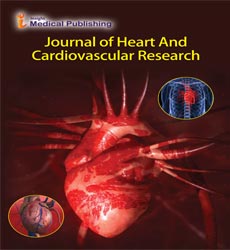ISSN : ISSN: 2576-1455
Journal of Heart and Cardiovascular Research
Health Trends in the US: Low Adherence to Exercise Guidelines and Poor Dietary Habits
James Rozanski*
Department of Cardiovascular Medicine, University of Maryland, Maryland, USA
- *Corresponding Author:
- James Rozanski
Department of Cardiovascular Medicine, University of Maryland, Maryland,
USA,
E-mail: rozanskij23@gmail.com
Received date: May 08, 2024, Manuscript No. IPJHCR-24-19369; Editor assigned date: May 11, 2024, PreQC No. IPJHCR-24-19369 (PQ); Reviewed date: May 27, 2024, QC No. IPJHCR-24-19369; Revised date: June 03, 2024, Manuscript No. IPJHCR-24-19369 (R); Published date: June 10, 2024, DOI: 10.36648/2576-1455.8.2.70
Citation: Rozanski J (2024) Health Patterns in the US: Low Adherence to Exercise Guidelines and Poor Dietary Habits. J Heart Cardiovasc Res Vol.8 No. 2: 70.
Description
Bad lifestyles such as physical inactivity and poor diet are very common in society and especially among patients with chronic diseases. The need to curb unhealthy lifestyles has led to the development of the new field of lifestyle medicine, whose mission is to prevent, treat and even reverse chronic diseases through lifestyle interventions. Three branches of cardiology are involved in that mission: Cardiac rehabilitation, preventive cardiology and behavioral cardiology. All three of these areas have made signi icant contributions to reducing cardiovascular disease morbidity and mortality.
Lifestyle factors
A joint action plan of the American College of Cardiology (ACC) and the American College of Lifestyle Medicine (ACM) could promote the use of behavioral interventions. This review suggests seven steps that these organizations and other medical organizations could share. First, it is necessary to develop and disseminate assessment of lifestyles as life factors during patient visits. Second, the development of a strong partnership between cardiology and physical therapy could improve important aspects of cardiac care, including the potential redesign of cardiac stress testing. Third, behavioral assessment at entry points of patient care must be optimized, as they can be considered windows of opportunity. Fourth, cardiac rehabilitation must be expanded into inexpensive programs and suitable for patients with risk factors but no known cardiovascular disease. Fifth, education in lifestyle medicine should be integrated with the core competencies of the respective disciplines. Sixth, cross-societal influence is needed to promote lifestyle medicine practices. Seventh, the beneficial effects of healthy lifestyles should be emphasized, such as their effect on the feeling of vitality.
Sedentary lifestyle
The scientific literature is abundant and convincing on the benefits of adopting positive health habits. Four habits deserve special emphasis in this regard: A physically active lifestyle, resistance training, maintaining a nutritious diet and adequate sleep. However, getting patients (and ourselves) to adopt and maintain these positive health habits is not easy. One reason for not adopting optimal health habits is that our environment has become increasingly unhealthy. In earlier periods of human history, adequate physical activity was a natural byproduct of the strain required to live and work. Most of the society was agricultural and most of the food was grown and consumed naturally and locally. Today it is possible to work and live successfully while maintaining a sedentary lifestyle. Added to this is a heavy reliance on modern transport, a sedentary workplace and a significant commitment to screen time and passive leisure entertainment. For the first time in history, most people need to be intentional about getting enough physical activity. In addition, our food environment has become toxic to health due to the in luence of many factors. Not long ago, there was no need for food labels or government guidelines to teach people how or what to eat. Today, guidelines and fences are essential. Life today is also faster and more complicated than it was a year ago, which makes positive lifestyles difficult. The result is poor health statistics only a quarter of the US adult population meets national guidelines for exercise and resistance training and that percentage declines with age. Diets are consistently poor and studies show that Americans consume nearly 60% of their calories from highly processed foods. Other countries have a similar pattern to the statistics for children. In addition, obesity has become a recent and global pandemic. Diabetes currently affects 11% of adults. More than a third of adults aged 55-64 have one or more chronic diseases and a quarter of those in their social circle at a safe age there are three or more chronic diseases. Unhealthy lifestyles have also contributed to the high spread of motor and musculoskeletal diseases in society. For this reason, efforts must be made to control the bad health habits prevailing in society. In response, lifestyle medicine has evolved into a new and growing ield of medicine. The main focus of lifestyle medicine is to use behavioral techniques and therapies to prevent, treat and correct chronic diseases such as diabetes and hypertension.
Open Access Journals
- Aquaculture & Veterinary Science
- Chemistry & Chemical Sciences
- Clinical Sciences
- Engineering
- General Science
- Genetics & Molecular Biology
- Health Care & Nursing
- Immunology & Microbiology
- Materials Science
- Mathematics & Physics
- Medical Sciences
- Neurology & Psychiatry
- Oncology & Cancer Science
- Pharmaceutical Sciences
